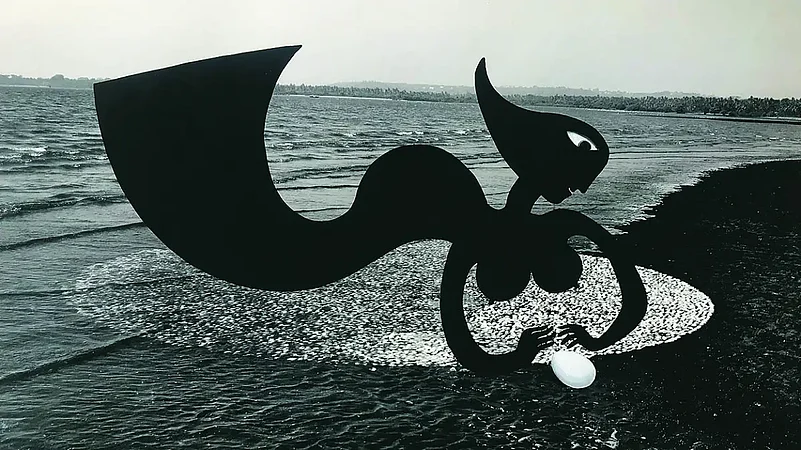“A fishing net, thrown at the point of India, brought in fifteen men of the seas which were immediately sent to the Lisbon Court. Thirteen died during the voyage. The only ones to survive were a woman and a young girl. They came to King Manuel who never grew tired of admiring them. The Oceanides appearing very sad, the King had them lowered into a shallow place in the sea, bearing light chains which prevented them from escaping. And the Court, aboard boats, were able to watch their evolutions. These creatures lived for a few years during which, each day, they were taken to the sea. But they were never able to learn to speak.”
Tears Of The Mermaid: The Melancholy Of Goa
The story of Goa is in many ways our story. And we decided to tell its story from the point of view of an old mermaid. We decided to make the mermaid speak to us.

— From a blog post on the depiction of mermaids
There were all these mermaids. Rising from the sea on the walls of Institute Menezes Braganza in Panjim in Goa, they are from the Island of Love in Canto IX written by Portuguese writer Luís Vaz de Cam?es first published in 1572 as an ode to the discovery of a sea route to India by the Portuguese explorer Vasco da Gama. The six azulejo panels are a mosaic of porcelain tiles that were fixed in Goa around 1935-36. In this one, the Greek goddess, Venus stands on a clam shell pushed by a merman and a mermaid, and is seen offering sailors refuge on this Island along with mermaids and sea creatures.
Goa is dotted with mermaids. Indigo statues that lead to the Museum of Goa. There must be some connection. I saw one in a fountain with a broken limb once in a garden called Jardim de Sereia (Mermaid Garden). In the 1970s, the garden was indeed a garden. Then, there was a beautification drive. Casinos appeared on the horizon and the mermaid became a painted lady with a pinkish torso with black eyes and red nipples. They say there were so many layers of paint on the white statue that it made her wavy hair straight. The statue was vandalised a few times and restored.
That’s how the conversation about mermaids came about. From the stories we read as children. Like The Little Mermaid by Hans Christian Andersen where a mermaid doesn’t get to live happily ever after despite her decision to bleed and become human for the sake of love. A line from that tale has haunted me since. “But a mermaid has no tears, and therefore she suffers so much more,” Anderson wrote.
***
They say the sea cures melancholy. I wanted to wave the book The Melancholy of Resistance by Hungarian writer László Krasznahorkai. It is a post-War avant garde fiction that knows augmentation and subtraction. But here, reality has been examined through fiction. A stuffed whale in hauled into a truck and taken to a decrepit town as part of a circus. The story has an apocalyptic feel. Magic and everything else.

We explored possibilities that night about a story of a mermaid in Goa, with all its promise of being that paradise that offers no solace. Mayabhushan Nagvenkar invented a mermaid. He named her Goa. She isn’t seductive like mermaids have often been imagined. She is old. She hasn’t aged well. Her fate is tied to Goa and its impending doom.
Goa’s resistance to money and new-age politics of polarisation is full of melancholy, and could be told through an allegory. Like avant garde fiction mixed with facts.
Goa is a place everybody escapes to. But where is the escape in advertised idyllic resorts? It is a homogenous mix of glass and steel buildings, of malls and development. There is no escape in this “elsewhere” place by the ocean that vomits plastic and other wastes.
There are hotel chains that want to sell “sustainable development” at a prohibitive cost, which might mean keeping out the rest. Segregation? Could be.
Then, there are those who wait for the return of the kingdom of Ram. There’s that Goa too. Temples and more temples and a lot of claims to regain what’s lost during the Portuguese rule. And then, there are stories of revival. Like Sonia Shirsat’s voice that has the power to slow down a wave. She sings the Fado, beautifully.
The story of Goa is in many ways our story. And that night we decided to tell its story from the point of view of an old mermaid. We decided to make the mermaid speak to us. We dared to do that. That’s storytelling.
(This appeared in the print edition as "A Mermaid Called Goa")
ALSO READ
- Previous Story
 Elections 2024: Ashok Tanwar Joins Congress Again; Sehwag Endorses Congress Candidate In Haryana
Elections 2024: Ashok Tanwar Joins Congress Again; Sehwag Endorses Congress Candidate In Haryana - Next Story

























